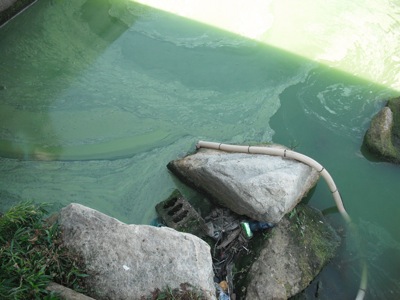Thursday, August 23rd, 2012
October report should tell if lake algae killed
Machine operating near intake pipe
By Nancy Allen

Photo by Nancy Allen/The Daily Standard
A Krie ionizer churns the algae-laden green water in Grand Lake on Wednesday. The unit is being tested in the lake near the Celina Water Treatment Plan intake pipe on U.S. 127 to see if it can kill toxic blue-green algae.
GRAND LAKE - A report showing whether a new machine installed in Grand Lake on Wednesday is killing toxic blue-green algae should be completed in October.
The Kria ionizer, located near the Celina Water Treatment Plant intake pipe off U.S. 127, will be tested for three weeks. No local money is being spent; the owner of the machine is funding the pilot study.
MAD Scientists Associates of Westerville will compile the report. Before the test began, representatives collected baseline data from the lake on dissolved oxygen, nitrogen, pH and ammonia levels; types and density of algae; and how much oxygen the algae uses when it decomposes, MAD Scientists owner Mark Dilley said. Data also will be collected during and after the pilot test.
"The most important thing we want to see is does it increase dissolved oxygen levels in the water and does it aid in the formation of an aerobic (oxygenated) layer in the sediment," Dilley said Wednesday. "Sediment with an oxygen layer can sequester phosphorous and prevent its release and resuspension into the water column; you want the phosphorous to stay down in the sediment, not come back up and fuel the algae growth."
The algae's main food source is phosphorous, which runs off mostly farm land in the 58,000-acre watershed.
The $299,000 ionizer negatively charges oxygen molecules and injects them into the water at a very high rate, pulling carbon out of any organic material, including algae. This destroys the algae, said Mike Mangham of Eco USA, importer of the Japanese-made machine. It also aerates and adds oxygen to the water, causing good bacteria in the sediment to grow and eat organic materials such as algae, pesticide and fertilizer.
Mangham said the units run on electricity and can treat a half-mile radius. No chemicals are used and no secondary pollutants are produced.
He suggested placing them a mile apart on the lake's shoreline. They can be placed on shore or in the water on a floating platform, he said.
A brochure on the technology touts its use in cleaning up Orange Beach in Alabama following the 2010 BP oil spill in the Gulf of Mexico. The ionizer has been used successfully in Asia for 10 years and the Middle East for five, Mangham said. A shipping company in Taiwan regularly cleans its ships' ballast tanks with it and in Saudi Arabia, dirty water has been reclaimed with the system, he added.
Mangham said the units have been used to treat a variety of water quality issues. The units speed up nature's own purifying process by increasing dissolved oxygen levels that help aquatic life, Mangham said.
As the unit slowly churned the water in Grand Lake on Wednesday, large schools of tiny minnows flocked around the swirling, green lake water.
Lake Restoration Commission Manager Milt Miller said he hopes the unit lives up to its promises in the brochure. The LRC has raised thousands of dollars in local donations to test technology that might rid the lake of its algae, which has resulted in state-issued water advisories and millions in lost business revenue the last four summers.
"We're receptive to all technologies if they can help our lake, and shame on us if we don't investigate every technology," Miller said.

